Kumbh Mela Facts, History, Information, Significance, Importance | What is the purpose of the Kumbh Mela? | Who started Kumbh Mela? | How many years to celebrate Kumbh Mela? | What is the secret of Kumbh Mela? | Why is Kumbh Mela celebrated
Namaste friends, how are you doing today? Welcome to #BhagavanBhakthi website / blog.
Bhagavan Lord Sri Vishnu (Venkateswara, Srinivasa, Balaji, Krishna, Rama, Trivikrama, Narasimha, Vamana, Vasudeva, Mukunda), Goddess Lakshmi (Rukmini, Satyabhama, Sita, Kamala, Maya) and Lord Sri Hanuman blessings to you and your family!
In this website / blog, you will always learn about #Hinduism #Sanskrit language.
Also subscribe to my YouTube channel #BhagavanBhakthi to view videos about #Hinduism #Sanskrit language.
Just before going to the “Kumbh Mela Facts, History, Information, Significance, Importance | What is the purpose of the Kumbh Mela? | Who started Kumbh Mela? | How many years to celebrate Kumbh Mela? | What is the secret of Kumbh Mela? | Why is Kumbh Mela celebrated“, let us have a brief idea and information.
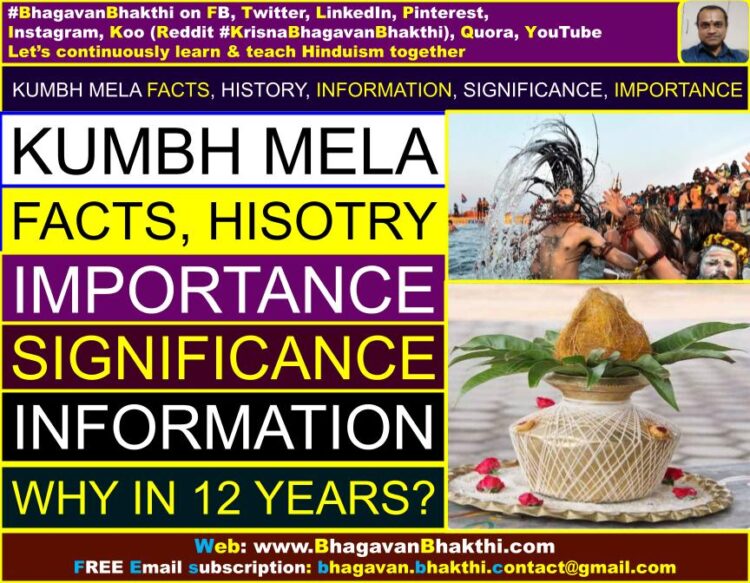
First of all, let us know what does the term ‘कुंभ / ಕುಂಭ / Kumbh / Kumbha’ signify: Literally, Kumbha means an auspicious water pot. It signifies a container and water in the pot.
[Remember the KumbhKarna of Ramayana. He was the brother of Ravana. He is so called because he had huge ears (Karna) and those ears were in the shape of Kumbh (pots) and thus the name KumbhKarna (KumbhaKarna).]
In a religious parlance Kumbha is compared with a Kalash(a), which is nothing but a Pot (घट / ಘಟ / ghaṭa / Ghata) containing water with other divine ingredients.
A Kalasha (or a Kumbha) is considered as highly divine and holy symbol in Hinduism (Sanatana Dharma).

A Kalasha can generally be made out of the following material, that is, earthen (mud), copper, brass, silver, gold depending on one’s capacity and occasion.
Also, Kumbha is an astrological sign Aquarius (i.e., Kumbha Rashi) 11th house in the natural zodiac whose Lord is Sri Shani Deva / Saturn.
Traditionally speaking, we should always remember that a Kalasha is being used in all the Hindu religious ceremonies, that is, Nitya Karma, Deva Karya (E.g., Daily Pooja, Homa, Vrata etc.), Shubha Karya (E.g., Marriage, Gruha Pravesha etc.); Pitru Karya etc.
Apart from the above, we also use Kalasha being on special occasions like while welcoming a distinguished personality (Purna-Kumbha).
In devalaya / temple ceremonies, we come across a ceremony called ‘Kumbhabhishekam’ (Kumbha Abhishekam) where, top of the temple tower (In Sanskrit it is known as ‘Shikhara’) is denoted as Kumbha is given a ceremonial sacred bath with holy waters at the time of consecration and also at periodical intervals.
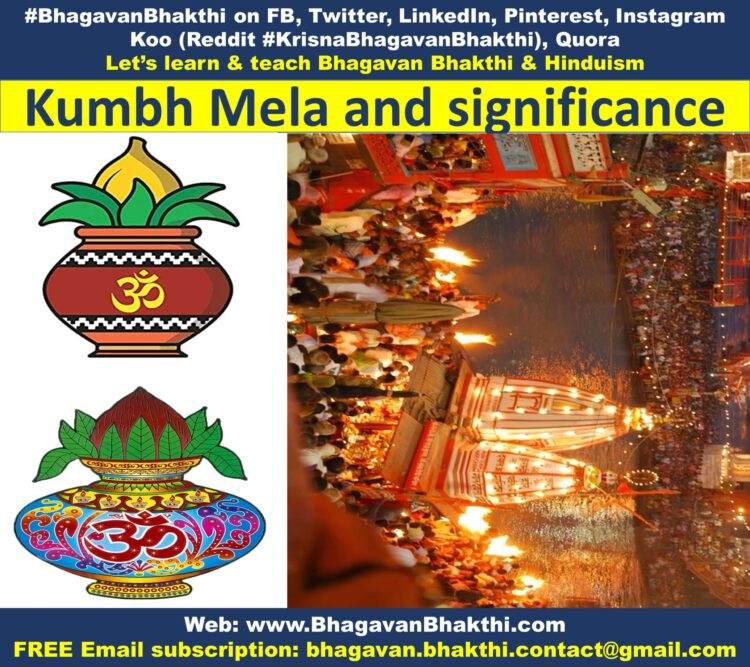
Next Kumbh Mela at Prayagraj : In the year 2025, Mahakumbh Mela will start from the bathing festival of Paush Purnima on 13 January 2025 and will end on Mahashivratri on 26 February 2025.
Kalasha shloka that we usually come across indicates the significance and symbolism of Kalasha:
कलशस्य मुखे विष्णु,कण्ठे रुद्र समाश्रितः |
मूले तत्र स्थितो ब्राह्मो मध्ये मात्रुगणास्म्रुतः ||
कुक्षौ तु सागरास्सर्वे सप्त द्विपा वसुन्धरा |
ऋग्वेदोऽपि यजुर्वेद: सामवेदोह्यथवर्णः ||
अन्गैश्च सहितासर्वे कलशाम्बु समाश्रिताः |
ಕಲಶಸ್ಯ ಮುಖೇ ವಿಷ್ಣು, ಕಂಠೇ ರುದ್ರ ಸಮಾಶ್ರಿತಾಃ |
ಮುಲೇ ತತ್ರ ಸ್ಥಿತೋ ಬ್ರಹ್ಮೋ ಮಧ್ಯೆ ಮಾತೃಗಣಾಸ್ಮೃತಃ ||
ಕುಕ್ಷೌ ತು ಸಾಗರಾಸ್ಸರ್ವೇ ಸಪ್ತ ದ್ವಿಪಾ ವಸುಂಧರಾ |
ಋಗ್ವೇದೋऽಪಿ ಯಜುರ್ವೇದ: ಸಾಮವೇದೋಹ್ಯಥರ್ವಣಃ ||
ಅಂಗೈಶ್ಚ ಸಹಿತಾಸರ್ವೇ ಕಲಶಾಮ್ಬು ಸಮಾಶ್ರಿತಾಃ |
kalaśasya mukhē viṣṇu, kaṇṭhē rudra samāśritāḥ |
mulē tatra sthitō brahmō madhye mātr̥gaṇāsmr̥taḥ ||
kukṣau tu sāgarās’sarvē sapta dvipā vasundharā |
r̥gvēdō̕pi yajurvēda: Sāmavēdōhyatharvaṇaḥ ||
aṅgaiśca sahitāsarvē kalaśāmbu samāśritāḥ |
Sloka meaning: Bhagavan Lord Sri Vishnu resides in the mouth of the Kalasha (Kumbha / Kumbh), Sri Rudra Deva (Shiva) is in the neck; At the bottom Sri Brahma Deva resides; in the middle are the divine mothers;
In the stomach exist all seas and seven islands of this earth; Rig Deva, Yajur Deva, Saama Deva and Atharavana Veda with all Vedangas are also present in the water.
In the ultimate way, a Kumbha signifies cosmic womb that of Bhagavan Lord Sri Vishnu who is Hiranyagarbhah and which is source of origin of the universe from where creation took place.
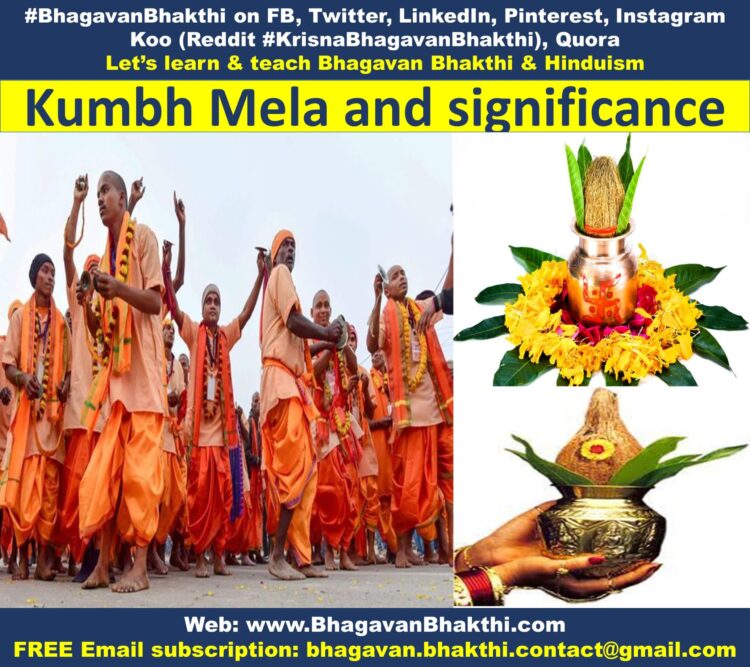
We should note that, Kumbha is one of the unlimited names of Bhagavan Sri Vishnu. The reference to this can be seen in the Sri Vishnu Sahasranama in shloka 68, that is,
अर्चिष्मानर्चितः कुम्भो विशुद्धात्मा विशोधनः ।
अनिरुद्धोऽप्रतिरथः प्रद्युम्नोऽमितविक्रमः ॥ 68 ॥
ಅರ್ಚಿಷ್ಮಾನರ್ಚಿತಃ ಕುಂಭೋ ವಿಶುದ್ಧಾತ್ಮಾ ವಿಶೋಧನಃ ।
ಅನಿರುದ್ಧೋಽಪ್ರತಿರಥಃ ಪ್ರದ್ಯುಮ್ನೋಽಮಿತವಿಕ್ರಮಃ ॥ 68 ॥
arciṣmānarcitaḥ kumbhō viśud’dhātmā viśōdhanaḥ।
anirud’dhō̕pratirathaḥ pradyumnō̕mitavikramaḥ॥ 68॥
Bhagavan Lord Sri Vishnu is the one who contains in Himself everything in the universe as water in a pot. Water is another form of Bhagavan Sri Vishnu – नारायण / ನಾರಾಯಣ / nārāyaṇa / Narayana whose abode is water, the one who moves (floats) in the infinite water and is also the water itself.
(Just after the MahaPralaya, Bhagavan Lord Sri Vishnu sleeps on a leaf. This leaf will be floating on water. For this reason, Bhagavan Sri Vishnu is also known as Narayana.)
(नारा / Naaraa means water, and Ayana means sleeping. This means, Bhagavan Lord Sri Narayana sleeps on the water after the MahaPralaya.)
Bhagavan Sri Vishnu is known as He is called as omnipotent (सर्वशक्त / ಸರ್ವಶಕ್ತ / sarvaśakta), omnipresent (सर्वव्यापि / ಸರ್ವವ್ಯಾಪಿ / sarvavyāpi) and omniscient (सर्वज्ञ / ಸರ್ವಜ್ಞ / sarvajña).
Therefore, the divine theory of of Kumbha Mela is nothing but, the worship of Bhagavan Sri Vishnu and thus he is known as जगद्योनि / ಜಗದ್ಯೋನಿ / jagadyōni / Jagadyoni (Bhagavan Sri Vishnu is the grand first of all).
Thus, we should always pay our obeisance to the primordial Sarvottama / Supreme Bhagavan Sri Narayana who is present in all the unlimited ‘Rivers and Teerthas’ as अंतर्यामि / ಅಂತರ್ಯಾಮಿ / antaryāmi / Antaryami.
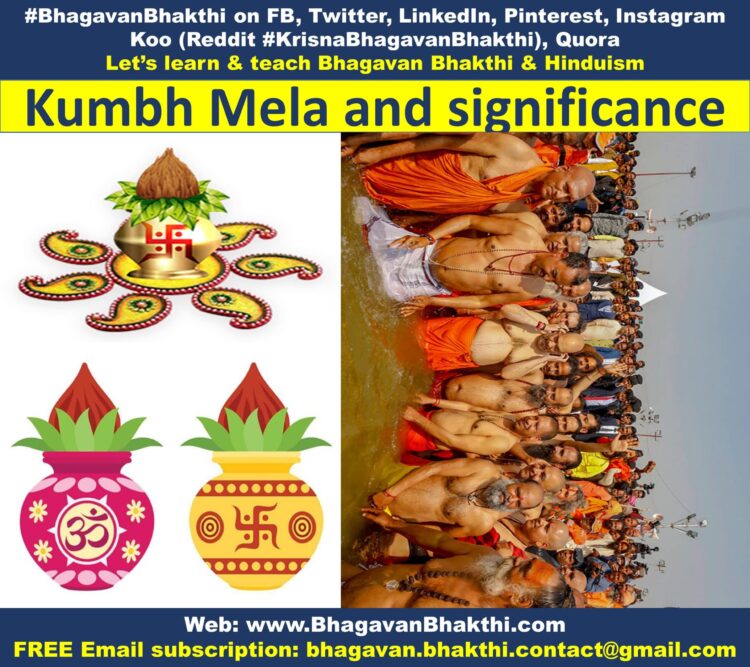
Information about festival Kumbh Mela: The Kumbh Mela, the celebration and festivity of the auspicious sacred kumbh / pitcher is anchored in Hindu Sanatana Dharma.
As we all know, Kumbh Meala is the largest open social gathering occasion and it is the collective act of holy beliefs & faith of India and this festival is celebrated since unknown age.
The Mela (A huge gathering) draws a large number of devotees from all over a country, through the span of 48 days to bath at the most holy waters of the most divine rivers of Triveni Sangam, that is, Ganga, the Yamuna, and the Guptagamini (The mysterious Saraswati).
Basically, this huge get-together incorporates not only common people, but also divine Saints, Sadhus, Ascetics, Sadhvis, Pilgrims etc. from varying backgrounds from not only all across India, but from around the world too.
In Hindu Sanatana Dharma, a Kumbh Mela is a Dharmic journey that is commended various times over a course of 12 years.
The geological area of Kumbh Mela spans over four locations in India, and the Mela site continues rotating between one of the four pilgrimages on four holy rivers as given below:
1. Prayagraj at the confluence of the Ganges, the Yamuna, and the legendary Guptagamini (Saraswati) in Uttar Pradesh.
2. Haridwar on the Ganges in Uttarakhand. 3. Ujjain on the Shipra in Madhya Pradesh. 4. Nashik on the Godavari in Maharashtra
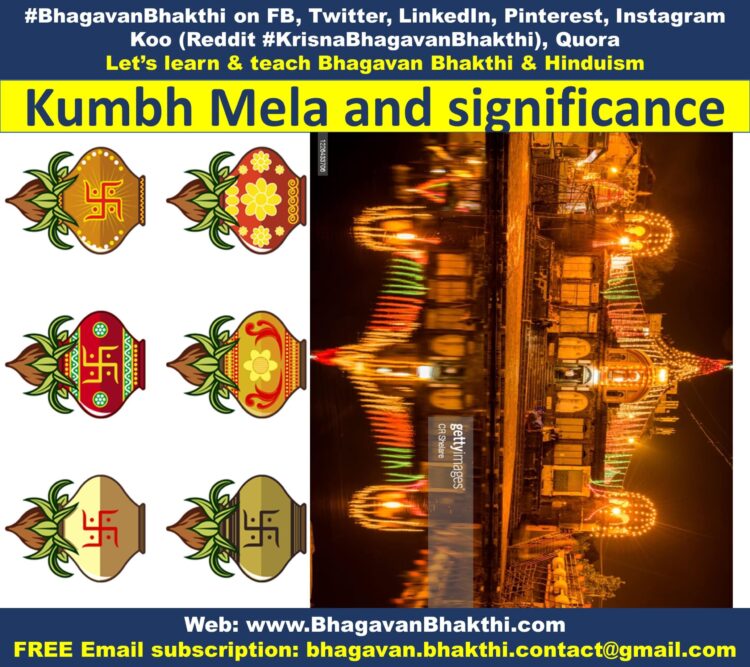
Bathing dates in Prayagraj Kumbh Mela: Taking a Snan (Divine bath) in the holy waters on all days of Prayagraj Kumbh beginning from Makar Sankranti (first day of the period of Magha maas, when the Sun enters Makar rashi / Capricorn) is viewed as highly blessed days, yet there are some divine showering dates too.
There are magnificent processions of saints and their disciples, and members of various Akharas take part in the holy custom of Snan (Divine bath) also known as ‘Rajyogi Snan’ at the start of Kumbh.
Snan (Divine bath) is the highlight of Kumbh Mela and the most important part of the festival, where large number of devotees take part in it.
It is basically after the Snan (Divine bath) is finished, that individual people are allowed to take the divine bath, in the belief that the people will get the added benefits of the essence of holy deeds and considerations of the saints by taking the plunge after them.
In Kumbh Mela, usually 12 crores of people / devotees took the Snan (Divine bath) at the auspicious Kumbh Mela.
More than 16 lakh devotees took a holy dip here at the Sangam of Prayagraj, that is, the confluence of Ganga, Yamuna and the Guptagamini (Mystical Saraswati), on the promising occasion of Makar Sankranti day, denoting the beginning of the Kumbh Mela.
Sadhus, Saints, Rishis, etc. of 13 akharas (That is, 7 Shaiva, 3 Vaishnava, 2 Udasina, and 1 Sikh) who have customarily taken an interest in the Kumbh Mela, were the first to take the holy bath known as ‘Shahi Snan’ (Divine bath) on the essential day of the 55-day long Kumbh Mela.
Usually, Lakhs of devotees take the ‘Shahi Snan’ or divine dip on ‘Mauni Amavasya’, which is the most significant of all the sacred bathing days at the Kumbh Mela.
Why Mahakumbh Mela at Prayag (Prayagraj) is celebrated once in 12 years?
Answer: Since unknown time, we Hindus are celebrating the Great Mahakumbh Mela at Prayag (Prayagraj) once in every 12 years. This is based on Brahaspati / Guru graha (Planet Jupiter) movement.
Anyone who knows about the movement of Brahaspati / Guru graha (Planet Jupiter) should know that, this graha / planet takes 12 Earth years to complete one full rotation around the Sun and definitely there is influence of this Planet Jupiter on Earth.
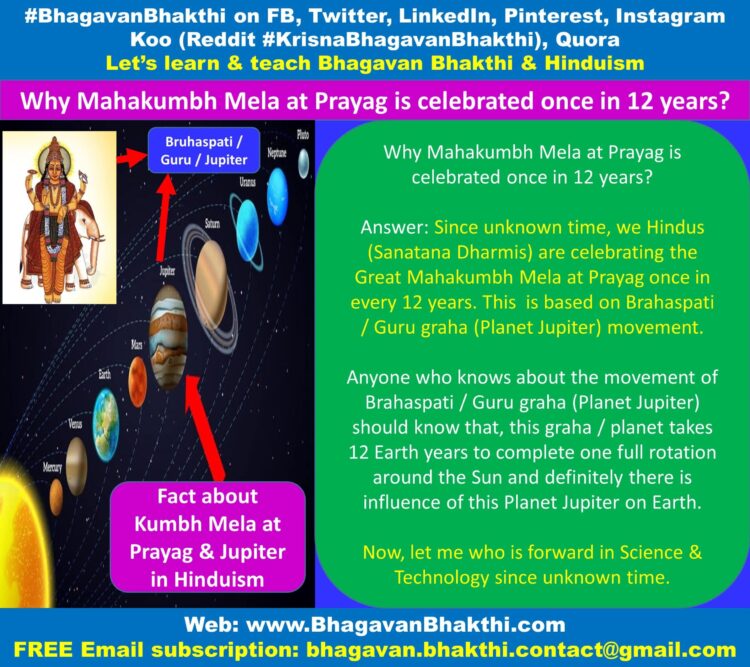
Now, let me know who is forward in Science & Technology since unknown time. Indians (Hindus) or so called educated or developed foreigners?
More information will be added to this on regular basis. Please this post and other posts of this website / blog to get the updated information.
To watch videos on #Hinduism #Sanskrit language, SUBSCRIBE to my YouTube channel from this link: #BhagavanBhakthi YouTube channel
To know more about the pilgrimage places of India, click this link: Pilgrimage places of India
To know “Venkatachalam hill (Tirupati / Tirumalai) names in different yugas”, click this link: Venkatachalam hill (Tirupati / Tirumalai) names in different yugas
To know more about Bhagavan Sri Srinivasa / Venkatesha / Balaji, click this link: About Bhagavan Sri Srinivasa / Venkatesha / Balaji on Bhagavan Bhakthi website
Dear friends, if you need any clarifications about this post, kindly let me know, I will definitely try to answer all of them.
Also your one LIKE, one COMMENT, One Share, one SUBSCRIPTION is highly important.
This will help to know the quality of this content and also it will be helpful to know if any improvements is required for the content.
If you feel this content is useful to you and has helped you to improve your knowledge, kindly share this with your well-wishers.
Because “SHARING MEANS CARING”.
To receive FREE EMAIL SUBSCRIPTION about #BhagavanBhakthi, you can send an email to [email protected] from your email ID.
NAMASTE!
Sri Gurubhyo Namaha
Sri Krishnaaya Namaha
Sri Krishnaarpanamastu
Share in Social Media